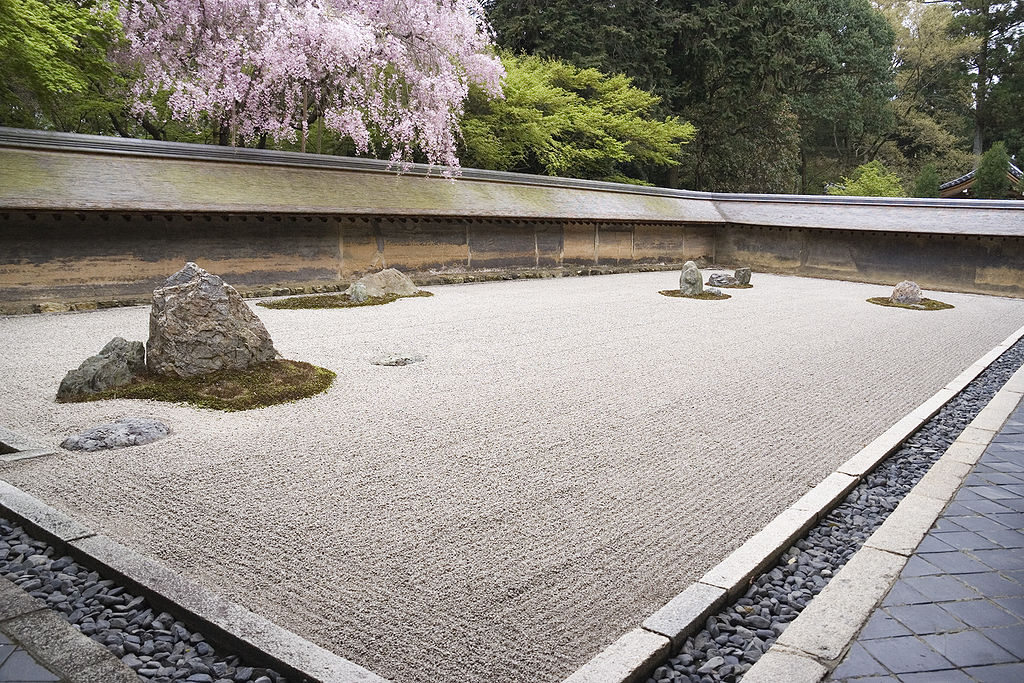Jim Jarmusch was quoted as saying "nothing is original, steal from anywhere". Some examples of Prof Swindells work was shown during his second year overseas placement whilst he worked in a studio in California. At the time Steve tended to use a six-foot by six-foot square canvas because he is 6 feet tall and had a six-foot arm span. So he therefore felt that he had a connection with the work through his own physiology.
References were made to the concept of Japanese Buddhists the Zen Garden is being the perfect space, with perfect sense of relationship, and the concept of the 15 stones representing 15 forces in nature, whereas the next stone can only become visible through the correct Zen Buddhist meditation. I read a little further about Zen Gardens;
"The most famous of all zen gardens in Kyoto is Ryōan-ji, built in the late 15th century where for the first time the zen garden became purely abstract. The garden is a rectangle of 340 square meters.[9] Placed within it are fifteen stones of different sizes, carefully composed in five groups; one group of five stones, two groups of three, and two groups of two stones.The stones are surrounded by white gravel, which is carefully raked each day by the monks. The only vegetation in the garden is some moss around the stones. The garden is meant to be viewed from a seated position on the veranda of the hōjō, the residence of the abbot of the monastery." -Nitschke, G. (2007), Le Jardin Japonais, pg. 90. (Taschen, 25th Anniversary). (ISBN: 9783822830444),
Ryōan-ji (late 15th century) in Kyoto, Japan, Ref; Wikipedia.com
The reason why this piece of Japanese art was selected is to help in describing the illusion of "being in the zone".
Other work that was mentioned was the work of Fishley and Vice, who have been big influences on Prof Swindell with memorable works like the vegetable sculpture and more commercially the Volkswagen adverts of moving objects in the form of Heath Robinson contraptions.
Prof Swindell's pop-up chicken hutches were also discussed, in which he introduced "unruly animals" into the studio.
Later work inspired by Patty Hearst case of the 1970s, in which she was taken hostage by a terrorist group, whilst kidnapped she actually defected to the terrorist cause, and wrote a famous text entitled "death to the fascists". This inspired the work of Prof Swindell in Amsterdam where he used the statements made by Patty Hearst by using parcel tape to create lettering but venues to a modelling knife to cut out the tape from parts of the lettering to make a unusual and difficult to read abstraction of Patty Hearst's plea.
The concept of "Nolens Vollens"; - Latin for to refuse and to volunteer has also been a cornerstone in some of his more recent works, which introduces Adobe Flash animation and drawing to include concepts of the modernist. The 'high colour' and grid concepts perhaps mirroring the work of Dutch painter Piette Mondrian are significant to these animations.
He has also experimented with psychodynamic interpretation or dialogue, through the use of random streams of words, backed with different primary secondary and tertiary colours in order to create word or sentence association in a random space.
The reason why all these different mediums were shown to us was to encourage us to use much more varied mediums, from computer graphic applications through to chicken hutches and Zen gardens!
He is also particularly interested in the phenomenon of industrialisation of modernism before post-modernism and how this progressed to the German Holocaust and therefore to the equal industrialisation of the 'atrocities' committed during the Second World War, such as the gas chambers, holding pens and logistics associated with the industrialisation of mass murder.
In reflection to my work, I realise through these examples but I need to build up more reference material as part of my research process to create new and original pieces for my studio practice. I mentioned the concept that I had been formulating of using the old Masters and the contemporisation of them, in reference to Thomas Gainsborough's painting Mr & Mrs Andrews.
Prof Swindell recommended that I look at the works of David Hockney (b1937) and suggested he also used Gainsborough's painting Mr and Mrs Andrews as a reference source of his painting entitled "Mr and Mrs Clark". I think this may be wrong though, as I may have misinterpreted the conversation.
 |
| Copyright David HOCKNEY, 1970-1971. Mr & Mrs Clark and Percy. (Ref; Tate Modern, T-01269). |
What a coincidence!... [Appropriation]... However I am now already thinking that my own series of paintings may take a new course, as a result of the review of Hogarth's series of engravings entitled "Marriage à la mode" earlier in the week... Clearly, my persuit of a series from Hogarth may havee been a good idea!
As a result I am now exploring in particular, the use of cloth, and its relationship with class culture and taste, and through a series of 6 to 8 paintings based on Hogarth's "Marriage à la mode", I am looking towards creating a narrative of the same.



No comments:
Post a Comment